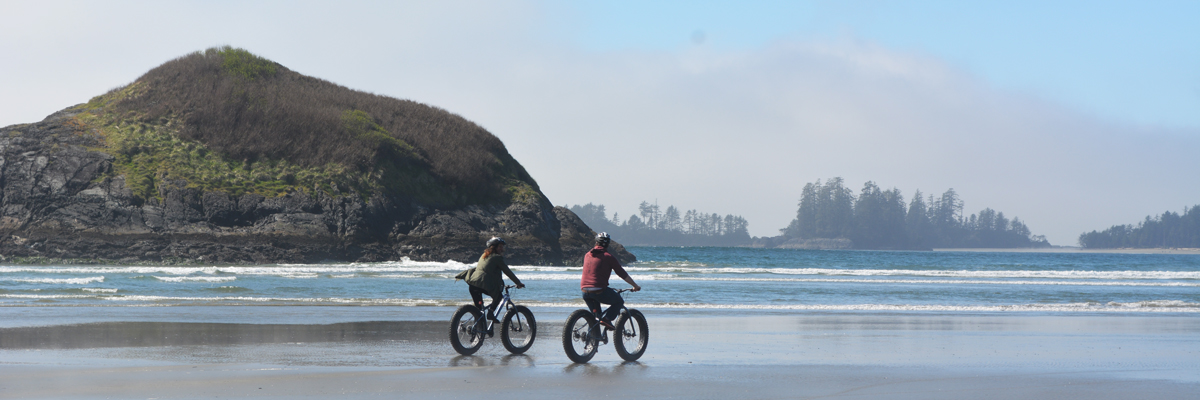
Avoid close encounters with birds and other wildlife when cycling on the beach.
Cycling, mountain biking, and e-biking
Pacific Rim National Park Reserve
Cycling to Pacific Rim National Park Reserve
If you are planning to cycle to the Long Beach Unit, be aware that Pacific Rim Highway (HWY 4) between Port Alberni and the West Coast is a challenging road for cyclists. This paved route is 108 km of steep, twisting mountain highway that often lacks shoulders. Heavy summer traffic compounds a hazardous situation. It is not recommended to bike this section of highway.
An attractive alternative to cycling HWY 4 is taking the passenger ferry service from Port Alberni, down the Alberni Inlet through Barkley Sound and the Broken Group Islands to Ucluelet. Once in Ucluelet, you are a 10 km cycle from the boundary of the National Park Reserve.
Cycling in the Long Beach Unit
The Long Beach Unit is the only unit of the national park reserve that is suitable for bicycling.
The portion of HWY 4 running through the national park reserve has a shoulder of variable width. Road cycling is not recommended on HWY 4.
Most of the hiking trails in the Long Beach Unit are designed for walkers. These trails have stairs and boardwalk and are not suitable for cycling. Cycling is only permitted on the beaches and on the ʔapsčiik t̓ašii multi-use pathway. Convenient bicycle access is available at Wickaninnish Beach and Long Beach parking lots via the beach access trails.
Pedal assist electric bikes (E-bikes)
Only pedal assist electric bicycles (class 1 e-bikes) are permitted on ʔapsčiik t̓ašii, the 25 km multi-use pathway traversing the Long Beach Unit. Class 2 or 3 throttle or e-bikes with speeds over 32 km/h are not allowed. Before you invest, be sure your e-bike meets the criteria that will be permitted on the pathway.
The following regulations should be respected at all times:
- Only regular manual bikes and pedal assist e-bikes (class 1) are permitted on Parks Canada designated trails and beaches.
- Pedal assist means that power assistance is only provided when the e-bike is being pedaled – when the pedalling stops, the power assistance stops.
- The motor of a pedal assist e-bike must not generate more than 500W, and the power assistance must stop when the speed reaches 32km/h.
- All electric bicycles and scooters with accelerators or throttles are prohibited on trails and beaches.
The use of pedal assist e-bikes is expected to have no different impact on the pathway than what is already experienced by regular bike use.
The three classes of e-bikes are defined as follows:
- Class 1: e-bikes that are pedal-assist only, with no throttle, and have a maximum assisted speed of 32 kilometers per hour.
- Class 2: e-bikes that also have a maximum speed of 32 kilometers per hour, but are throttle-assisted.
- Class 3: e-bikes that are pedal-assist only, with no throttle, and a maximum assisted speed of 45 kilometers per hour.
Remember, you are responsible for your own safety
- Always wear a helmet and safety gear. Know your equipment.
- Get advice at a Parks Canada Information Centre, including trail conditions, descriptions and weather.
- Pack adequate water, food, gear, maps, first aid. Carry bear spray and know how to use it.
- Tell someone where you are going and when you are expected back. Do not travel alone.
Related links
- ʔapsčiik t̓ašii (Multi-use pathway)
- 150 adventures for your bucket list
- Birding
- Boating
- Camping
- First Nations cultural experiences
- Fishing
- Geocaching
- Hiking
- Hiking: West Coast Trail
- Kapyong Memorial at Radar Hill
- Kwisitis Visitor Centre
- Red Chairs
- School and group programs
- Storm watching
- Surfing
- Volunteer opportunities
- Licensed operators
- Date modified :